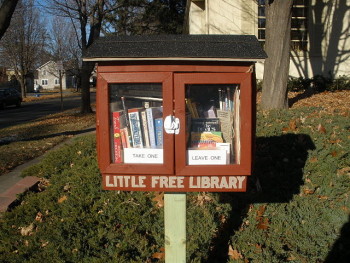A Little Free Library
February 24, 2015
“There is not such a cradle of democracy upon the earth as the Free Public Library, this republic of letters, where neither rank, office, nor wealth receives the slightest consideration.”
~ Andrew Carnegie
I often take a walk around my neighborhood, both for exercise and to daydream. The other day I was heading down a local street and saw something at the edge of a neighbor’s front lawn that hadn’t been there the last time I passed by. A small box with glass doors in the shape of a little library sat atop a wooden post stuck into the grass at the edge of the sidewalk. “Take a book; leave a book” read a small sign on the front. This Little Free Library was filled with previously read and obviously well-loved books. How cool! I thought. I remembered having seen a story somewhere about these community book-sharing boxes. I was delighted to have one nearby.
In 2009, Todd Bol, a man in Wisconsin, built a small replica of a one-room schoolhouse, placed it on a post in his front yard, and filled it with books to share. He built the miniature library as a tribute to his schoolteacher mom, who loved to read. The little library was such a hit with neighbors and friends that Todd built and gave away several more.
It wasn’t long before Bol and his friend Rick Brooks, of the University of Wisconsin-Madison, decided to promote literacy and the love of reading by building and sharing these tiny free book exchanges around the world. Inspired by Andrew Carnegie, who founded 2,509 libraries in the late 19th and early 20th centuries, they turned their backyard project into a movement and, in 2012, Little Free Library was established as a non-profit organization.
From their website:
A Little Free Library is a “take a book, return a book” gathering place where neighbors share their favorite literature and stories. In its most basic form, a Little Free Library is a box full of books where anyone may stop by and pick up a book (or two) and bring back another book to share.
As of January 2014, the total number of registered Little Free Libraries around the world was estimated to be at least 15,000.
You can build or buy a Little Free Library for your neighborhood. Go to littlefreelibrary.org for more info. You can also watch a short video on how Little Free Libraries work by clicking here.
~~~~~~~~~
Happy Chinese New Year! Celebrate the Year of the Goat by making some Homemade Goat’s Milk Ricotta.
Homemade Goat’s Milk Ricotta
Homemade “ricotta” is easy to make yourself. Ricotta cheese is traditionally made by heating the whey that is left over from making other cheeses. This simpler method uses warmed whole milk, salt and vinegar to form the curds and only takes about 30 minutes or less of your time to make (most of which is simply waiting). Using goat’s milk instead of cow’s milk makes for an interesting flavor and a special treat that your lactose-intolerant friends will appreciate. I found grass-fed, humanely-raised goat’s milk at my local Trader Joe’s.
Note: whether you use goat’s milk or cow’s milk, check the label to make sure the milk is pasteurized, but not ultra-pasteurized. Sometimes the ultra-pasteurized milk will not form the curds properly.
4 cups whole goat’s milk
1/2 teaspoon sea salt
3 tablespoons distilled white vinegar
You will need a medium to large sized mesh strainer and
A piece of fine cheesecloth (strong paper towels may be substituted)
In a large, heavy soup pot or saucepan, over medium heat, heat milk and salt until milk just begins to simmer (milk will be foamy around the edges and tiny bubbles will begin to form on the surface, but it will not be boiling).
Remove pan from heat. Add vinegar and stir only once or twice, until you see curds begin to form. Do not stir past this point! Let stand a full minute.
Line a mesh strainer with a piece of clean cheesecloth and place this over a large bowl (you can use a strong paper towel for this purpose in a pinch, if you don’t have any cheesecloth on hand).
Slowly pour the liquid and curds into the cheesecloth. Make sure the strainer is not sitting in the liquid, so that it can continue to drain freely. If necessary, you can pour the excess liquid (whey) into another container (you will want to save this for another use). Do not disturb/stir the curds.
Let the curds drain over the bowl for about 12 to 35 minutes, depending on whether you desire a moist or a dryer texture for the ricotta (goat’s milk makes smaller curds than cow’s milk and takes a bit longer to drain).
Spoon the cheese into a bowl and let it come to room temperature. Use immediately in a recipe (lasagne, manicotti, cannoli, etc.) or cover and refrigerate for up to 5 days.
You can mix in a little extra virgin olive oil or mayo, along with some fresh herbs and a pinch of salt and pepper. Basil pesto is also a nice addition. Serve this as an appetizer with chips or crackers, as an addition to a salad, or spread on a sandwich.
Note: save the leftover liquid and add it to your pasta cooking water or the liquid you use to make rice or soup. This will add a nice flavor.
Makes about 1 & 1/2 cups

Recent Comments